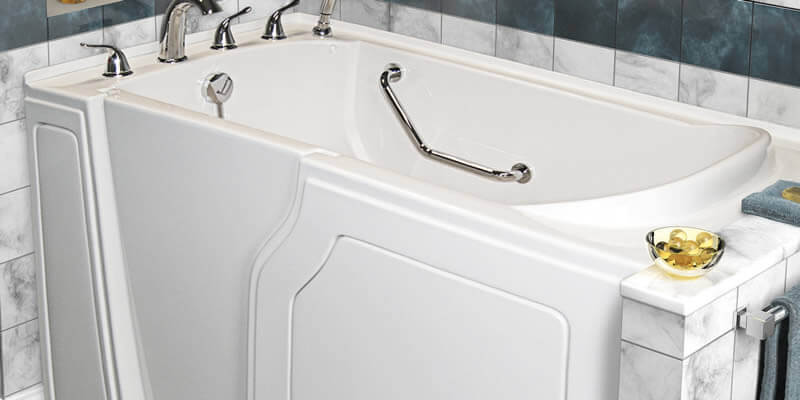Walk-In Bathtub Installation Cost Range
Most homeowners can expect to pay between $3,500 to $24,500 to have a walk in tub installed depending on many of the factors discussed below. Needless to say, the price is higher than for standard shower or tub replacement.
When you choose a reputable plumbing contractor to handle the walk-in tub install, it will usually include removal and disposal of your old bathtub or shower. All plumbing and electrical (if needed) prep work for the new walk in tub, and the walk-in unit itself. All installation supplies and labor, as well as any permits and inspections needed in your local area.
Average Cost
The cost to add a handicap accessible walk-in bathtub in your bathroom is between $8,500 – $21,500, when installed by a local plumber. You can save by installing the tub yourself, but it will often require permits and inspections, and a licensed plumber may be required.
Overview of Walk In Bathtubs
Homeowners thinking ahead often add a walk-in tub during bathroom remodeling. Others wait until necessary to add a handicap tub that allows access over a ledge much lower than standard height.
Types of Walk In Tubs
- Soaking tub: A basic accessibility tub with no extras.
- Hydrotherapy walk-in tub: Whirlpool tub, with jetted water for soothing massage action.
- Air bath: A walk-in tub which is fitted with a blower to produce millions of small air bubbles. They offer gentler action than hydrotherapy and are recommended for those with circulation issues and diabetes. These are also called bubblers.
- Combo tub: Type that offers both gentle bubbling and dynamic hydrotherapy.
- Bariatric walk in tub: These walk in bathtubs are made with added support to handle more weight.
Potential Money-saving Tip: The National Council on Aging says that while walk-in bathtubs are usually not covered by Medicare Part B and Part C might allow for a walk-in tub if it is medically necessary and more affordable options are not possible.
Many Options and Accessories are Available
- Practical features: Adjustable heated seating and backrest, fast-filling and draining, hand-held showerhead, shower enclosure, ozone sanitation or UV light for cleaning, extra wide door or seat, seat cushion, safety bars and faucet selection. Wheelchair accessible tubs are also available.
- Therapeutic features: Hydrotherapy, air bath therapy, chromotherapy using colored LED lights, aromatherapy, sound/music therapy,
Walk In Bathtub Cost Factors
The cost to have a walk-in tub installed in your bathroom will depend on a variety of factors. The main cost factors are:
- Tub Type – Basic tubs with no performance features cost the least. Practical and therapeutic features are listed above, and each adds to the price.
- Extras – There are add-ons for many tubs such as aromatherapy, light therapy and extra grab bars. They add on cost too.
- Tub Size – The smallest are about 48”x24”; the largest are about 80”x48”. Average sizes include 50”x36”, 48”x32” and similar.
- Quality – It varies greatly. One good metric of quality is weight rating. The cheapest have a weight limit below 200lbs, not including water. The top rating is 500lbs from most manufacturers. We recommend choosing one with a rating of at least 75 to 100lbs above the weight of the people that will use the tub.
- Installation Factors – Modifying or adding plumbing or electrical, widening of a doorway and moving a toilet or sink are changes that significantly raise installation cost.
- Who Installs It – When installation is supplied by the tub dealer, cost will usually be higher than if you hire the installer directly.
- Where you Buy – You’ll save money by shopping around to many stores and dealers. You’ll pay more on average if you limit your options to in-home consultants with high-dollar bathtubs.
Walk In Tub Retail Prices and Installation Supplies
Retail Cost of Walk-in Bathtubs
Here are common styles and their retail cost for the tub only. Installation prices follow.
The range in price is based on the factors listed above.
- $1,900 – $6,200 | Walk-in Soaking Tub (no electrical components other than heated seat)
- $2,100 – $7,000 | Walk-in Tub & Shower Enclosure
- $2,400 – $7,200 | Walk-in Bariatric Tub (high weight-bearing)
- $2,000 – $7,700 | Walk-in Hydrotherapy Tub / Jetted Tub
- $2,250 – $7,750 | Walk-in Air Bath
- $2,700 – $8,900 | Combination Hydrotherapy and Air Bath
A walk in bathtub with all possible accessories sold through a high-profit, in-home consultation can surpass $12,000. The list gives the most common ranges.
Ways to buy a walk-in tub
- Online retailers sell a full range of models from cheap to high-end in quality and features. They’ll ship it to you, and you can hire a plumber for installation.
- Home improvement stores like Home Depot and Lowes sell basic to mid-grade tubs in a limited range of models. You can hire a local plumber or contract one through the store.
- Local distributors: Major brands have local outlet stores where their models can be viewed and purchased. You can have your own plumber install it or buy a package that includes installation.
- Kitchen and bath stores: They have a wider range of models than local distributors and can arrange installation at your option.
- In-home sales: A representative will come to your home with sales brochures and videos and, in many cases a high-pressure sales pitch. Most offer one or two lines of walk in bathtub, and prices are higher than the other buying options.
Find the installer before buying: This allows the plumber to visit your home and check out the bathroom layout, plumbing and electrical, if needed. The plumber will advise you on key issues like tub size the bathroom can accommodate, where the drain should be and what modifications will have to be made during bathroom remodeling and at what cost.
Getting help with handicap tub cost: If a health care professional prescribes a walk-in tub for a specific condition such as diabetes or circulatory issues, it may be tax deductible.
Medicare might help cover the cost. The Senior List says, “The Medicare Advantage Plan (specifically Part C) and Medicaid may provide financial assistance. Both agencies are monitored at the state level rather than at the federal level, and each state has its own interpretation of what constitutes Durable Medical Equipment (DME).”
Veterans can apply for a VA grant or other financial aid.
Low-income families can apply for a Socially Disadvantaged Groups grant from the USDA’s Rural Development Program or a grant or low-interest loan from its Single Family Housing Repair Loans & Grants program.
Permits, Inspection, Related Costs & Installation Time
Permits and Inspection Cost
- $85 – $325 | A permit is needed if plumbing is being changed. A separate electrical permit is required if the tub must be wired. If you’re doing a complete bathroom remodeling project, then the permit cost will be based on the square footage affected, and cost will be higher than listed here.
Related Costs and Installation Time
We’ve covered the cost of a walk-in tub, but not its installation.
- $800 – $1,650 | Simple installation with little or no modification to plumbing
- $1,500 – $2,500 | Installation requiring changes to plumbing
- $1,950 – $2,800 | Installation requiring plumbing and electrical modifications or additions
Install Time Schedule
Expect your bathroom to be tied up for 3 days to 2 weeks based on the installer’s schedule and complexity of the work. The timeframe will look something like this:
- 1-2 Days | Remove the old tub and ceramic tiles if needed.
- 2-7 Days | Modify and/or add plumbing and electrical.
- 1-3 Days | Install the accessibility tub.
- 2-5 Days | If new shower wall tiles or bathroom floor tiles are added, it will take another 2-5 days work.
Related Projects
Are You a Pro Walk-In Tub Installer?
If so, head over to our Costimates Pro’s page, and help us make this page better and more accurate for both our visitors and your future customers.
DIY or Hire a Pro?
Installing a soaking tub with no or very little plumbing changes is a moderately difficult job for someone with good skills. Getting the drain right is essential. If you fail there, the water damage might be extensive. In our opinion, it makes sense to pay the $1,000 or so for an experienced installer even with a “simple” installation.
When changes to plumbing are needed and/or wiring has to be installed, pro installation is highly recommended.


 Steve Hansen, that's me, the Senior Editor of Costimates. (
Steve Hansen, that's me, the Senior Editor of Costimates. (